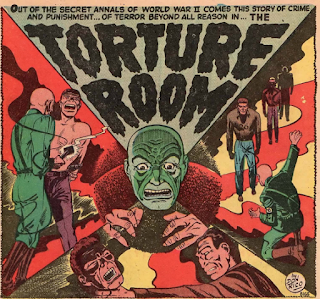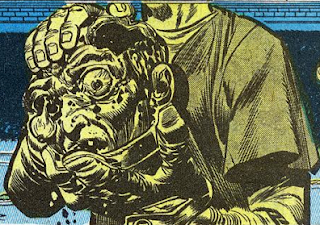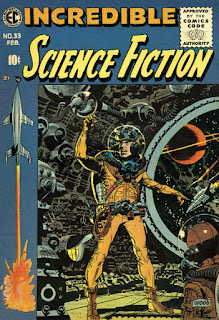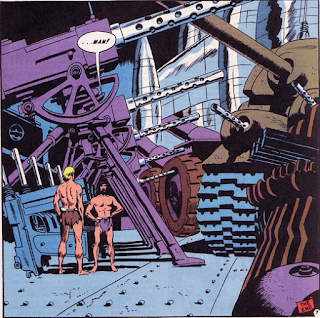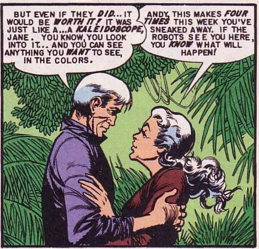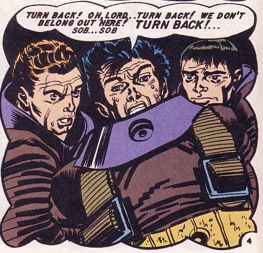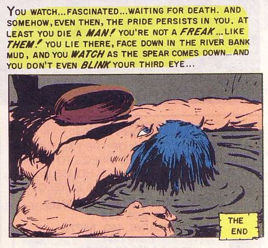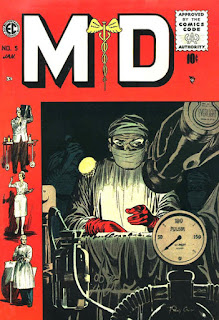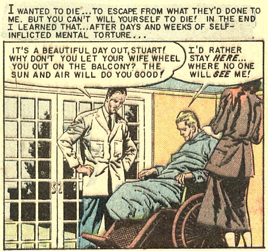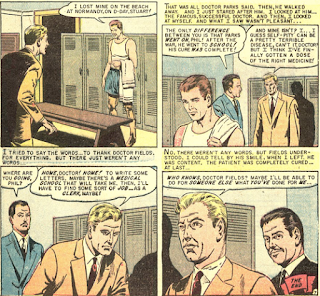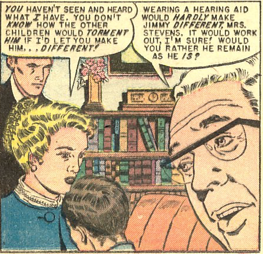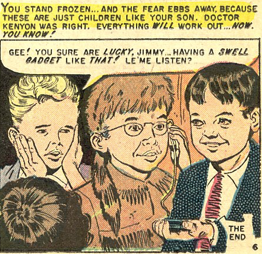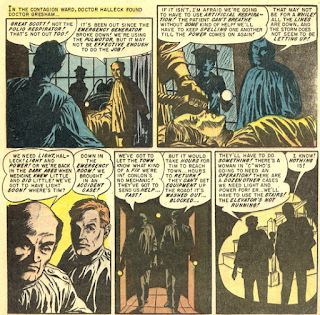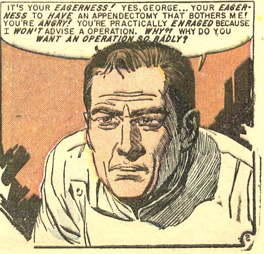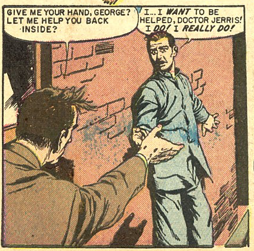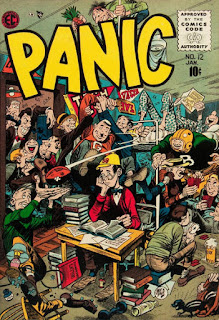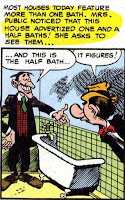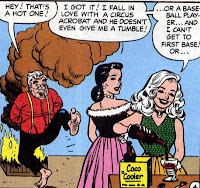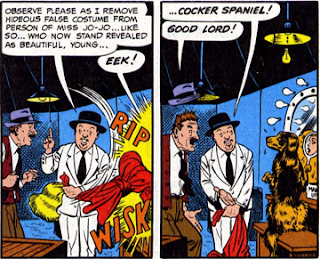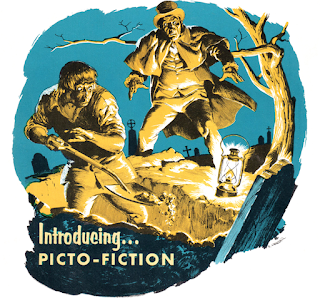The Marvel/Atlas
Horror Comics
Horror Comics
Part Eight
June 1951
Strange Tales #1
"The Strange Men" (a: Paul Reinman) ★
"The Beast" (a: Manny Stallman) ★
"The Room That Didn't Exist" ★
"A Call in the Night" (a: George Tuska) ★
Navy pilot Ted Halsey flies through a strange cloud and comes out the other side needing fuel so he lands at the first small Pacific island he can find. Fresh out of the cockpit, Ted is manhandled by "The Strange Men," brutes in astronaut suits, who take him to an elaborate underground city. There, Ted learns that invaders from Saturn (who can walk through walls) have landed on Earth and are capturing Navy pilots to help dig for uranium. Not one to be whipped and chained, Halsey escapes in one of the Saturnian bomber jets and heads for Washington to alert General Mortell of the upcoming invasion. Typically, the Army brass doesn't see it Ted's way and has him hospitalized as a looney. After our hero has left, the General radios his Saturnian comrades and then walks through his office wall.
 |
| Ted demonstrates the proper way of exiting |
Boy, how many times have we seen that ending? EC alone must have used it a half-dozen times. But what makes "The Strange Men" so special is the rest of the idiocy attached. Why do the men from Saturn go to the trouble of luring Navy pilots to the island, only to have them perform chores any strong man could do? And why have they built an elaborate city underground if they intend to take over the surface world? And why are they wanting to conquer Earth (and "eventually, every planet in the solar system!") in the first place? The final page shows just how lax security was in the 1950s as Ted flies his experimental Saturn jet right in Washington with nary a blinking of a military eye. Fun, but deadly dumb.
A crazed anthropology fanatic, Paul Lorenze, meets an equally crazed mad doctor and is transformed into a gorilla in "The Beast," a wildly shambolic mess whose sole attribute is its inanity; you will literally not know what the uncredited "writer" will come up with on the next page (and, I'm fairly certain, he had no idea either). For instance, Lorenze interrupts the scientist in the midst of a mad experiment designed to turn a gorilla into a man. He quizzes the nutty professor as to whether there's a formula that will vice the versa (it's always been Lorenze's secret desire to become a gorilla!) and, sure enough, one exists in the lab across the way! How about that? Manny Stallman's art is primitive and sketchy, not an easy style to like, but we better get used to it as he'll be around for a while. Stallman later illustrated some of those great (I say "great" in a nostalgic sense) giveaway funny books from Bob's Big Boy.
Horror writer James Reston has exhausted inspiration in his usual digs ("I want a somber background for my new novel of horror! Up to now I've been able to find it on Park Avenue!") and so travels to Germany where superstition runs rampant. There, he stumbles into the Black Forest and into a quaint inn, run by a gorgeous damsel named Luren. The babe-a-licious redhead woos and wins the scribe with her feminine ways but the new kid in town irritates Lumen's old beau and a fight breaks out, with Luren getting a dagger in the back. Reston flees the inn to get help but when he gets back he discovers the building is in ruins. The local doctor tells the flabbergasted wordsmith that the pub burned down in 1616! "The Room That Didn't Exist" is another dopey charmer populated with over-the-top purple prose and cliched ghostly hauntings. Some examples, you say?:
As we crossed that strange room, I could see the others staring and pointing at me and could almost feel a dooming hate in their sinister eyes...
There seemed something cruel and evil in her claim upon me, but I saw it only as flattering and exciting...
In her kiss I felt more than passion, a demonic fury of icy mockery as her whole being trembled in the ecstasy of some secret and dark triumph...
Those are some serious feelings there.
In the final tale this issue, "A Call in the Night," TV repairman Joe is called out of his nice warm home and into a frightful storm by Mr. Grey, whose TV is on the fritz. Joe arrives at a spooky, run-down mansion, where Mr. Grey summons Joe into a room and asks the damp repairman to fix his ancient set. Joe "repairs" the blown-out tubes but finds a puzzling picture on the screen: his wife, Mary, transformed into a statue! Mr. Grey informs Joe that he "does work for people who wish to be rid of others in their way!" Joe's wife's Aunt Sue has just died and made Sue the benificiary; this doesn't please Sue's greedy relatives. Joe is locked in a cell and screams... until he wakes up. Sue gives her hubby a hug and tells him he's had quite the nightmare but now he's safe. The phone rings and a Mr. Brown asks Joe to come fix his set... Atlas cliche #14 gets another once-over: the dream ending that keeps repeating.
Though this is one awful issue of Strange Tales, the arrival of the title actually brings a big smile to my face. Yes, the first few issues are pretty mangy (I'm warning you right now) but things warm up pretty quickly after that. How the hell would I know? Glad you asked. Several years ago, I began an offshoot of the Marvel University blog under the umbrella of "The Pre-Superhero Issues." It was a great idea (If I do say so) and I had the best of intentions but the workload proved too much (I was writing for several blogs at the time as well as for a few print zines) so all that got published were posts on the first forty issues of Strange Tales (though the reading and sketchy notes were completed for the first twenty issues of Journey Into Mystery as well). There are some real gems coming your way via ST but you'll just have to be a bit patient. If you'd like to read the ST posts, the links are located at the bottom of this page (but rest assured, those posts will be cannibalized for this blog).
Strange Tales, of course, became a showcase, first for the Human Torch (#101-134) and later Dr. Strange (#110-168), and Nick Fury, Agent of SHIELD (#135-168), before being dry-docked for a few years. But here's where it gets complicated. After Issue #168, the comic was re-titled Doctor Strange and continued the numbering until #183, when it was cancelled in November 1969. When Marvel decided to resuscitate the title in September 1973 (with another supernaturally-tinged hero, Brother Voodoo), they continued the numbering from the old series yet again. Brother Voodoo ran from #169 (Sept. 1973) through #173 (April 1974) and then relinquished the title to the Golem for three issues, Warlock for four, and Dr. Strange and golden age monster reprints for the balance before hitting the comic graveyard again with #188 (November 1976). The title Strange Tales was used by Marvel a few more times over the years (the most notable being as an anthology featuring 10 page stories starring Cloak and Dagger and Dr. Strange) but I believe contemporary comic readers are not fond of the anthology concept so the "reboots" are always short-lived. Thus far, Marvel has seen fit to issue the first 48 issues of Strange Tales in five Masterworks volumes.
 |
| Bill Everett |
"The Little Man Who Wasn't There!"
(a: John Tartaglione) ★★★
Casper Waltham is a man you, as one of his co-workers puts it, could set your watch by. He never eats out, he doesn't touch the hard stuff, he's prompt to work, he never eats beef on Wednesday; he's a creature of habit. So why does Casper suddenly go off the rails and enjoy the sins he's avoided all his life? The poor man's "double life" finally lands him in hot water when he's arrested for bank robbing. There's only one answer, Casper decides, and that's that he's a fictional character trapped in a story and forced to perform his creator's every plot contrivance. The doctors, of course, think Casper's crazy but then that might be because, as we see in the final panel, they are creations in a story too! A wildly imaginative little yarn that you can never really second-guess. Halfway through the story, I was assuming Casper had a doppelgänger but, six panels from the end of the story, the uncredited author (Stan? Hank Chapman?) had me tripping over my own feet but rising from the floor with a huge grin on my face. "The Little Man Who Wasn't There" is a second kin to "The Nightmare"(Astonishing #4, below).
Journey Into Unknown Worlds #5
"Look -- If You Dare" (a: Bob Brown) ★★1/2
"Trapped in Space" (a: Mike Sekowsky) ★
"The Last Plunge" (a: Jack Abel) ★★
"Two Worlds in One!" (a: Chic Stone) ★
Poor Ambrose Jones! He's gotten a new telescope from that strange little store around the corner and now he can see everything that's happening on Mars, Jupiter, and Venus. These three planets are joining together for an invasion of Earth; Ambrose is certain of it. He heads for the defense department but his theory is debunked by a high-ranking official; after all, they have telescopes and an ear open for anything in the wind. How could Ambrose be onto something that none of the nation's top astronomers have a clue about? Flustered, Ambrose heads home to monitor the situation but is met there by the salesman who sold him the telescope, who informs our wanna-be hero that a big mistake was made and the wrong telescope was sold to Ambrose. The salesman is an early scout for the coming invasion party. He clocks Ambrose and takes the super-telescope with him, leaving the poor little man waiting for the inevitable downfall of civilization. "Look -- If You Dare!" is not a bad little fantasy tale, with some nice art by Bob Brown, an artist I'm not all that familiar with but a quick look at his bio reveals I've seen a lot of his stuff before. Brown's main claim to fame was as an artist on DC's science-fi title, Challengers of the Unknown, but he also helped to launch one of Marvel's most popular western characters, the Rawhide Kid. There's some good, atmospheric visuals here, definitely a cut above most of the trek we've seen in the fantasy yarns.
Sometimes I forget these things were written with little kids in mind and it takes an inane little bit of nonsense like "Trapped in Space" to remind me. Carnival owner Ollie Clyde welcomes a new act into his fold, a unique act billed as "The Room From Which You Never Return!" (which would have made for a more ideal story title, by the way), run by an odd little man named Zodus. The nattily-garbed showman promises that, for a quarter, you will never return to Earth again. Naturally, it's a hit and the carnival becomes the talk of the town until a detective from the Missing Persons Bureau comes to question Ollie about the rash of disappearances that began roughly the same time as the new attraction. To show the cop the whole thing is a gag, Ollie enters the room himself and finds himself falling ten thousand miles into the center of the Earth (good trick that, since the Earth's diameter is approximately 8000 miles!) where he discovers a vast civilization run by Zodus and bent on the conquering of mankind yaddayaddayadda.... We've heard this a million times before (perhaps an exaggeration roughly equal to the distance to the center of the Earth but I feel I'm a bit closer) from a dozen different publishers and this one doesn't end much better. Ollie's fall is not only interesting for its depth but also for the fact that, after falling ten thousand miles, he's caught in a net without breaking any bones. Mike Sekowsky's art resembles that of an early Steve Ditko but there's no pizzazz at all; it just sits there.
Depressed by the death of his wife, George Louka commits suicide by leaping off a bridge but, instead of the desired effect, Louka finds himself in an undersea world. Look is welcomed by the beautiful Laura, who explains to George that all suicides by drowning end up in this purgatory and eventually become fish. "Holy mackerel," thinks George, but this man has other ideas and he convinces his gorgeous new gal to join him in an escape to the surface world. The break-out goes well, and the couple are married, but the honeymoon goes sour when Laura asks the excited groom for a towel while she's in the shower and George discovers there's something fishy about his new bride. "The Last Plunge" is pretty tame fantasy, with a bit of an underlying religious moral, until the final couple of panels when things go very bizarre. Our old DC war pal, Jack Abel, proves his stuff was just as generic in the 1950s as in the 60s.
Last up is the lame "Two Worlds in One!," in which a con man is lured into the future by scientists who need 20th Century secrets to come up with... something. Who knows? It's never really resolved. Our hapless dope catches a black plague from his frequent journeys between time zones but he's caught and jailed and makes his last stand in the courtroom in a laughable finale. There were some really bad/really average artists doing work for Atlas in the 1950s and to their ranks you can add Chic Stone, whose choreography consists of panels filled with talking heads and little else.
 |
| Bill Everett |
"The Nightmare" (a: Wayne Boring) ★★1/2
Funny book writer “Hank” (as in Chapman) eats and drinks wild concoctions before bed, all the better to ratchet up those bad dreams and create fodder for his stories. His editor, “Stan,” gives him a new assignment but warns it has to be “Better than any one ever published before!” It also has to feature a man who gets lost in a “weird, fantastic nightmare.” Knowing he has to come up with something great, Hank downs several quarts of ice cream and pickles and heads off to bed to receive the golden prize. But Hank gets lost in his dream and all the monsters he’s written of in the past come back to haunt him. Hank wakes to find he’s become a monster and is trapped inside an issue of Astonishing! As the opener in a one-two punch of inside jokes, “The Nightmare” isn’t quite as good or imaginative as “The Little Man Who Wasn’t There” (see Venus #14), but it’s got a much wilder and stylish visual style; Hank’s dreams are a montage of exaggerated creatures seemingly pulled from Dante’s Inferno.
 |
| Carl Burgos |
"The Brain!" (a: Russ Heath) ★★★
(r: Crypt of Shadows #11)
"Hands of Murder"
(a: Mike Sekowsky & Christopher Rule) ★1/2
(r: Crypt of Shadows #11)
"The Torture Room" (a: Don Rico) ★★
(r: Chamber of Chills #11)
"Vampire Brats" (a: Allen Bellman) ★
(r: Crypt of Shadows #11)
"The Thing in the Water"★
(r: Crypt of Shadows #12)
Though Nazi scientist Otto von Schmittsder has been executed for his heinous war crimes, his brain lives on, thanks to the work of ally Fritz and a handy buzzsaw. Otto needs a good henchman though and he latches onto weak (but deep down inside conscientious) GI Larry (who’s always wanted to be a world-dominating scientist). Otto teaches Larry how to make a bacteriological bomb and the pair use it to kill thousands but Larry gets a case of the regrets when the Brain orders him to kill Larry’s best pal. Larry turns the gun on himself and Otto’s head hightails it out the back door to find another slave. “The Brain” is the best kind of Atlas horror, one that’s filled with great art, a whopper of a plot, and enough crazy dialogue and plot devices to keep the pages turning. Otto’s head is an interesting object, one not confined to a vat of liquid like most beheaded noggins. No, this one's mobile, bouncing to and fro or, as in one phenomenal scene, up a staircase rail! Will the sequel to this epic be just as tense and thrilling? Stay tuned for coverage of Adventures Into Terror #6.
In “Hands of Murder!," poor Trudy can’t convince her physician that her dead sister, Janet, has reached out from the grave to strangle her to death until it’s too late. When the doc examines Trudy’s X-rays, he discovers bony hands wrapped around Trudy’s throat. Very average 1950s horror with pedestrian art and a predictable finish; especially disappointing after the lead story. A sadistic Nazi commandant has the tables turned on him in "The Torture Room," which has a nicely ironic, if a bit far-fetched, finale. Don Rico is fast becoming one of my favorite of the "second-tier" Atlas artists. "Vampire Brats" soars by "far-fetched" deep, deep, deep into "inane" territory with its lame plot centering around a daft nurse who takes a job at a vampire hospital (and the job was advertised in the paper!).
Henry Crane has an unnatural love for guppies so when the local fish merchant tells him that there's a strange guy down the street selling a "superior strain of guppies," Henry just has to have a look. The man (who looks quite a lot like a fish himself, strangely) plays hard to get at first but finally sells Henry a pair of the super guppies and our protagonist hurries home, a happy man. But, soon after getting the aquarium home, a talking water creature emerges from the tank and tells Henry that its a surviving Atlantean and Henry will do its bidding. Sure enough, the monster has some kind of mind control over the hapless fish lover and, soon, Henry starts acquiring the characteristics of a mackerel (much like the weirdo who sold him the tank). As Henry's health declines, the monster demands a new slave: Henry's daughter. The unwitting girl comes knocking but Henry gets a last-second attack of conscience and commits suicide by jumping into the aquarium. A really dopey tale that is almost saved by its charm and awful graphics in a "so bad it's good" way (the creature is a podgy, pigeon-toed guffaw) and its head-scratching finale. But it's still really really bad.
Marvel Tales #101
"The Man Who Died Twice!" (a: Paul Reinman) ★★1/2
"The Spider!" (a: Larry Woromay) ★★★
"The Voice of Doom" (a: Gene Colan) ★1/2
"The Hidden Men" (a: Morris Weiss) ★★
Larry Adams doesn't believe in fate so he considers his buddy Willie's constant blathering, about how all our lives are decided from the day we are born, to be nonsense. During one of these arguments at the golf course, a strange man appears and tells Larry that Willie is correct but Larry just laughs him off as an actor hired by Willie as a prank. Then the man begins to appear wherever the boys turn up and nerves start to fray. On a business trip aboard a plane, the man greets Larry just as the motor catches fire and the plane goes down. The stranger asks Larry if he'd like a second chance at life to avert fate and Larry quickly agrees. Presto! He's waking up from a nightmare and back on the "there's no such thing as fate" bandwagon.
However, he does see the dream as a premonition and so decides to take his business trip by car. While he's passing the airport, Larry gets a case of the guilts and pulls in to warn the pilot of his dream. Larry's warning is laughed off and the plane takes off on schedule. Also on schedule, the plane catches fire and heads for Earth, right into the path of Larry's car! This poor guy just can't dodge his fate. It's along one at seven pages (a couple probably could have been shaved off without missing a beat) but Paul Reinman's art is pleasant enough and that twist is a good one (sure, it's been used since but it's still effective). I always thought it was a nice change of pace when Atlas (or any of the other horror comics publishers) would rein down terror on good guys as well as those who deserve a nasty end. It plays with our expectations, doesn't it?
Since he was a wee boy, Benjamin Blair has been fascinated by insects; he loves to catch them and pull off their legs, wings, and other body parts. Then a medicine show comes to town and Benjy is fascinated with one of the owner's attractions, a rare spider known as a Lycosa. Benjy steals the writer and takes it home, where he watches it grow, its appetite growing along with it, into a giant killer. Along the way, "The Spider," now named Taranta, ingests (in chronological order) mice, cats, dogs, cows, and horses, stoping along the way to inject some nasty venom into Benjy's ma and pa (the doctor says he's never seen anything like it -- "their entire bodies are rapidly growing a fuzz... somewhat like a spiders (sic)!"). Now an orphan, Benjy enjoys the run of the house (and the neighborhood) with Big Taranta until Farmer Willie comes to the door looking for his cat, dog, and cow, and ends up a meal for Benjy's soul mate. On the run, Benjy and Taranta hide out in a cliff cave but hunger gets the best of the jumbo arachnid and he takes a bite out of Benjy. The enraged young man kills his pet but then finds himself sprouting "silky fuzz" and eight legs, doomed to carry on the Lycosa tradition.
Of all the Atlas short stories I've ingested so far, this is the most disturbing and nastiest, with a lead character so vile it's a wonder Stan waved the checkered flag on "The Spider." And in a title like Marvel Tales to boot, a book that's been wading in pablum since it switched formats eight issue before? It's almost as though Harvey (whose lovely and vile Black Cat Mystery had, at this time, not yet changed formats from superhero to extreme horror) or Ace (whose Web of Mystery was still pumping out fairly tame fare), publishers we now know to have pumped out some pretty extreme stuff, had slipped into the Atlas office and snuck a reject into Stan's pile.
The overall vibe I get from "The Spider" is the same I get from one of Eerie's black and whites (Terror Tales, Tales of Voodoo, etc.) of the 1970s; it's a queasy feeling but also one of excitement for finding such a sick and loopy gem. All rationale is jettisoned, no explanations forthcoming (Why do Benjy's parents die before transforming into spiders but Benjy makes the leap?), and that's just the way I like it sometimes. Larry Woromay's visuals are crude and sleazy, the perfect choice for a script of this nature. And who the hell would have figured Hank Chapman would take a break from writing about rooms that go on forever or men who have seven fingers to type out something this skin-crawly?
Harry's murdered his wife, Gloria, but now hears her st-st-stuttering voice inside the room where the deed was committed. Driven to the brink, he turns to his buddy, Greg, a psychiatrist, for help. Greg recommends, of course, that his friend buy a parrot so that the bird will mimic anything said in the room; in that way, Harry will realize there's no "Voice of Doom" at all. The boys purchase a Mexican parrot and lock it in the room; the bird seems upset by a presence but, as Mark notes, it's "a shame it doesn't speak English!" A few days later, Greg arrives back at the flat for a progress report and the parrot starts singing about Harry's crime in Gloria's st-st-stuttering voice and then heads for the open window. Harry, intent on throttling the fowl, leaps out the window to his death. And just like that, we're back to the simple nonsense Marvel Tales is best known for. One wonders where Greg got his degree in psychiatry when he prescribes such an... offbeat... cure for madness for his best friend. And if you haven't gotten the fact that poor Gloria was a "stutterer" by the third panel, you are definitely napping through "The Voice of Doom" (and I wouldn't blame you):
Nothing had terrified me in that room... nothing till that horrible moment when the stuttering echo of murdered Gloria's voice returned...
"Gloria is dead! I killer her, and her stuttering voice that jarred my existence is silenced forever!"
"H-H-Harry! W-why did you m-murder me?"
"That voice! That stuttering voice! It's Gloria's!"
S-s-subtlety. At least Gene Colan is slowly but surely transforming into the artist we know and love, eschewing the extreme scratchiness we've seen in previous work for Atlas and using shading to greater effect. It's the saving grace for this hogwash.
Alice and Bob decide to rent out the room upstairs and a funny little man named Jasper answers the ad, paying three weeks in advance but asking for a lock on the inside of his door. Though the request is peculiar, the couple oblige and enjoy nearly three weeks of peace until their friend, Frank, drops in for a quick salutation and then heads off. The new boarder enters the room in a tizzy, explaining that Frank is an interplanetary invader whose comrades are out to silence Jasper by any means possible. Ignoring the man's eccentricities because "his money is good," the couple nonetheless tell Frank not to drop by anymore. One day, when Bob and Alice have had enough, they head upstairs to tell Jasper he'll need to move on when they discover that the man has already... moved on. The room is vacant but for a detailed plan to ward off the space invasion. The doorbell rings and it's a police officer, notifying the couple of the accidental death of Jasper. The couple are stunned but receive even worse news when Frank, sprouting natty antenna from his head, comes by to request the Space Invasion Avoidance Plan. Alice is killed but Bob escapes to warn the world of the impending attack. Alas, no one believes him and he's sent to the loony bin where a doctor sporting the same outer space headset injects Bob with a silencer.
While it's nowhere near the level of "The Spider" (nor "The Man Who Died Twice!," for that matter), "The Hidden Men" is a fun six pages of 1950s commie hysteria à la Invasion of the Body Snatchers (which wouldn't be released for another half-decade, by the way). Like Larry Adams in "The Man Who Died Twice!," Bob is just a working grunt who probably hasn't even kicked a dog in his lifetime and sweet Alice bakes cookies for the neighborhood bake sale every week. These are Good Sams caught up in a situation not of their making, and they meet an undeserved end. Thank goodness.
 |
| This month's Heath-head |
 |
| In two weeks! Basil Wolverton invades the Atlas Universe in a double-sized Holiday Issue! |
The Marvel University Strange Tales Saga:
Digging Deeper Part One
Digging Deeper Part Two
Digging Deeper Part Three
Digging Deeper Part Four














